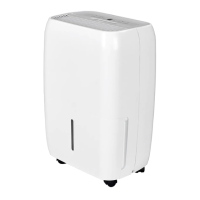6
ENGLISH
10. Repairs to sealed components
During repairs to sealed components, all electrical supplies shall be disconnected from theequipment
being worked upon prior to any removal of sealed covers, etc. If it is absolutely necessary to have
anelectrical supply to equipment during servicing, then apermanently operating form of leak
detection shali be located at themost critical point to warn of apotentially hazardous situation.
Particular attention shall be paid to thefollowing to ensure that by working on electrical
components, thecasing is not altered in such away that thelevel of protection is affected. This
shall include damage to cables, excessive number of connections, terminals not made to original
specification, damage to seals, incorrect fitting of glands, etc.
• Ensure that apparatus is mounted securely.
• Ensure that seals or sealing materials have not degraded such that they no longer serve
thepurpose of preventing theingress of flammable atmospheres. Replacement parts shall be
in accordance with themanufacturer’s specifications.
Note: Theuse of silicone sealant may inhibit theeffectiveness of some types of leak detection
equipment. Intrinsically safe components do not have to be isolated prior to working on them.
11. Repair to intrinsically safe components
Do not apply any permanent inductive or capacitance loads to thecircuit without ensuring that
this will not exceed thepermissible voltage and current permitted for theequipment in use.
Intrinsically safe components are theonly types that can be worked on while live in thepresence
of aflammable atmosphere. Thetest apparatus shall be at thecorrect rating. Replace components
only with parts specified by themanufacturer. Other parts may result in theignition of refrigerant
in theatmosphere from aleak.
12. Cabling
Check that cabling will not be subject to wear, corrosion, excessive pressure, vibration, sharp
edges or any other adverse environmental effects. Thecheck shall also take into account
theeffects of aging or continual vibration from sources such as compressors or fans.
13. Detection of flammable refrigerants
Under no circumstances shall potential sources of ignition be used in thesearching for or detection
of refrigerant leaks. Ahalide torch (or any other detector using anaked flame) shall not be used.
14. Leak detection methods
Thefollowing leak detection methods are deemed acceptable for systems containing flammable
refrigerants. Electronic leak detectors shall be used to detect flammable refrigerants, but
thesensitivity may not be adequate, or may need re-calibration. (Detection equipment shall be
calibrated in arefrigerant-free area.) Ensure that thedetector is not apotential source of ignition
and is suitable for therefrigerant used. Leak detection equipment shall be set at apercentage of
theLFL of therefrigerant and shall be calibrated to therefrigerant employed and theappropriate
percentage of gas (25 % maximum) is confirmed.
Leak detection fluids are suitable for use with most refrigerants but theuse of detergents
containing chlorine shall be avoided as thechlorine may react with therefrigerant and corrode
thecopper pipe-work.
If aleak is suspected, all naked flames shall be removed/extinguished. If aleakage of refrigerant is
found which requires brazing, all of therefrigerant shall be recovered from thesystem, or isolated
(by means of shut off valves) in apart of thesystem remote from theleak. Oxygen free nitrogen
(OFN) shall then be purged through thesystem both before and during thebrazing process.

